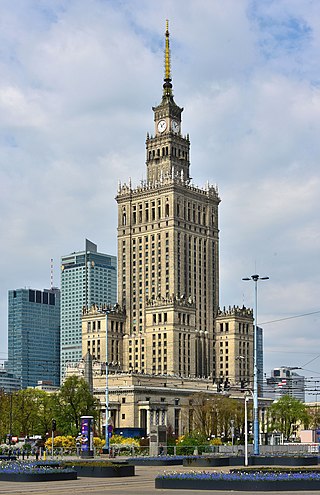
The Palace of Culture and Science is a notable high-rise building in central Warsaw, Poland. With a total height of 237 metres (778 ft), it is the second tallest building in both Warsaw and Poland, the sixth tallest building in the European Union and one of the tallest on the European continent. At the time of its completion in 1955, the Palace was the eighth tallest building in the world, retaining the position until 1961; it was also briefly the tallest clock tower in the world, from 2000 until the 2002 installation of a clock mechanism on the NTT Docomo Yoyogi Building in Tokyo, Japan.

Branicki Palace is a historical edifice in Białystok, Poland. It was developed on the site of an earlier building in the first half of the 18th century by Jan Klemens Branicki, a wealthy Polish–Lithuanian Commonwealth hetman, into a residence suitable for a man whose ambition was to become king of Poland. The palace complex with gardens, pavilions, sculptures, outbuildings and other structures and the city with churches, city hall and monastery, all built almost at the same time according to French models was the reason why the city was known in the 18th century as Versailles de la Pologne and subsequently Versailles de la Podlachie.
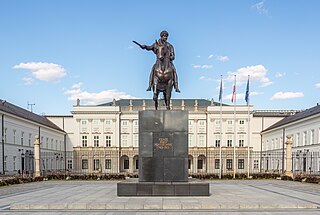
The Presidential Palace is the official residence of the Polish head of state and president alongside the Belweder Palace, located in Warsaw, Poland. Originally constructed in 1643 as an aristocratic mansion, it was rebuilt and remodelled several times over the course of its existence by notable architects. The current neoclassical palace was completed in 1818.
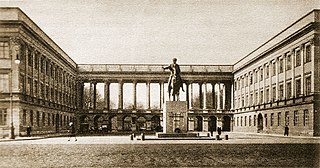
The Saxon Palace was, before World War II, one of the most distinctive buildings in Warsaw, Poland. After the suppression of the 1944 Warsaw Uprising, the palace was destroyed by German armed forces as part of their deliberate destruction of Warsaw.

Wilanów Palace is a former royal palace located in the Wilanów district of Warsaw, Poland. It was built between 1677–1696 for king of Poland John III Sobieski according to a design by architect Augustyn Wincenty Locci. Wilanów Palace survived Poland's partitions and both World Wars, and so serves as one of the most remarkable examples of Baroque architecture in the country.
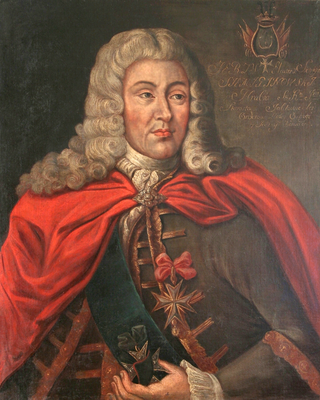
Jerzy Siemiginowski-Eleuter was a prominent Polish painter and engraver of the Baroque era. He was court painter to king John III Sobieski and a Polish–Lithuanian noble. He is considered one of the most accomplished painters of Classical Baroque in Poland. His works combine the classical approach with native elements.

The Krasiński Palace, also known as the Palace of the Commonwealth, is a reconstructed Baroque palace in Warsaw, Poland, on Krasiński Square. Initially erected between 1677 and 1683 for the powerful Krasiński family, it was heavily damaged during World War II and rebuilt in the mid-20th century.

The Branicki Palace is an 18th-century magnate's mansion in Warsaw, Poland. Situated at the junction of Podwale and Miodowa Streets, it was constructed for the aristocratic Branicki-Gryf family in the Rococo style. The palace is known for its elaborate sculptures and statues above the cornice.

The Palace on the Isle, also known as the Baths Palace, is a classicist palace in Warsaw's Royal Baths Park, the city's largest park, occupying over 76 hectares of the city center.

Mostowski Palace is an 18th-century palace in Warsaw, Poland, located at ul. Nowolipie 2 — prior to World War II, at ul. Przejazd 15.

Tylman van Gameren, also Tilman or Tielman and Tylman Gamerski, was a Dutch-born Polish architect and engineer who, at the age of 28, settled in Poland and worked for Queen Marie Casimire, wife of Poland's King John III Sobieski. Tylman left behind a lifelong legacy of buildings that are regarded as gems of Polish Baroque architecture.

The Casimir Palace, formerly known as Villa Regia, is a reconstructed palace located in Warsaw, Poland. It is adjacent to the Royal Route, at Krakowskie Przedmieście 26/28.

The Potocki Palace is a large baroque palace in Warsaw, located at Krakowskie Przedmieście 15, directly opposite the Presidential Palace. It was originally built for the Denhoff family and in the late 18th century became the property of the Potocki family.

The Bishop's Palace in Kraków is the seat of Kraków metropolitan Curia, Poland, and the traditional residence of Kraków bishops since the late 14th century. It is the second largest palace in the city after Wawel, former seat of the Polish monarchs. It is part of a monastery complex of the Franciscan religious order. Bishop's Palace is best known for being the residence of Pope John Paul II during his stays in the city. He used to give his blessings and talk to his followers from a window above the main entrance at night.
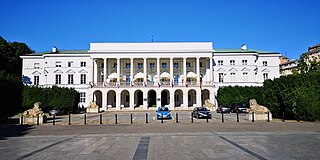
Lubomirski Palace is a palace in central Warsaw, which was built in the 18th century for the Radziwiłł family.

Przebendowski Palace is a Baroque palace in Warsaw, built in the first half of the 18th century for Jan Jerzy Przebendowski, currently the seat of the Polish Museum of Independence. It is located between the carriageways of the main road 62 "Solidarności" Avenue.

The Konstanty Zamoyski Palace is a historic building on ulica Foksal in Warsaw, Poland.

Pac Palace is a historical building, located by Miodowa Street in Warsaw, Poland.

Młodziejowski Palace (Polish: Pałac Młodziejowskiego, Polish pronunciation:[ˈpawat͡smwɔd͡ʑɛjɔvˈskʲɛɡɔ], also the Morsztyn Palace, is a palace located in Warsaw at 10 Miodowa Street, with annexes at 7 Podwale Street. The palace was erected in the Baroque style at the end of the 17th century. It is adjacent to the Branicki and Szaniawski palaces.
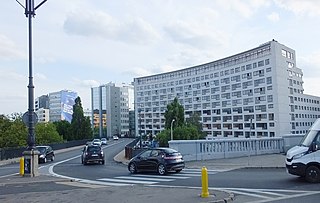
Solec is a neighbourhood along the Vistula river in Warsaw, the capital of Poland. It is situated east of Frascati on the southeastern edge of Downtown and south of the Powiśle suburb. Solec was a self governing settlement and town from 1675 until its incorporation into Warsaw in 1791. The name "Solec" is derived from the Polish word for salt – sól – which was extensively traded and transported through the neighbourhood since the late Middle Ages. However, contemporary Solec is mostly occupied by residential tower blocks and commercial buildings.





















